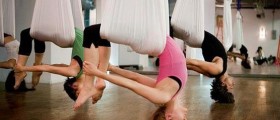
Ashtanga yoga, also known as Ashtanga Vinyasa Yoga, is the ancient system of yoga popularized by the contemporary yogi called K. Pattabhi Jois. Yoga is a practice of natural healing and self-improvement that originates from more than 500 years. The word yoga is derived from Sanskrit language and often translated as the union, conjunction or joining. What most of the people have in their mind today when we talk about yoga is the typical physical exercise involving different postures and stretching. However, poses typical for yoga are just one aspect of this complex discipline. Some of the yoga schools emphasize the postures, called asanas, but Ashtanga yoga offers a more traditional approach to this ancient system, including eight different aspects of yoga teaching. These aspects are known as the eight limbs of yoga, and they include:
Yama – the moral codes,Niyama – self examination and purificationAsana – posturesPranayama – breathing techniquesPratyahara – control of the sensesDharana – intentionDhyana – meditationSamadhi – contemplation
Principles of Ashtanga yoga
Ashtanga yoga stands out from other types of yoga by emphasizing the alignment of movement and breath. Typical yoga postures include series of movement which are usually held for a specific number of breaths. In Ashtanga yoga, these postures are performed in a dynamic flow, and the practitioner is in a constant motion during the class. The length of inhale or exhale is the time that a practitioner spends in a transition between postures. Unlike some other types of yoga, Ashtanga yoga insists on breath. The breathing is the priority of every class and the practitioner should try to make the breath deep, rich and flowing, and absolutely non-reactive to a physical effort. Breathing is, for Ashtanga yoga, the epitome of quiet mind and symbol of persistence in the constant change.
Benefits of Ashtanga yoga
As already mentioned, Ashtanga yoga differs from the other types of yoga by moving the focus of the practice from asanas to other, more spiritual, aspects. There are no specific Ashtanga yoga postures. This discipline uses the same classic positions, usually starting with the sun salutation, but performs them in a more dynamic, flowing way.
This way, Ashtanga yoga builds up the practitioner’s flexibility, stamina and endurance, while keeping the muscles strong and improving the blood flow. Keeping a posture for a while helps massage the internal organs and increases their activity. In addition to numerous physical benefits, Ashtanga yoga is a fantastic way to get relief from stress, soothe the mind and work on self-improvement.

















Your thoughts on this
Loading...